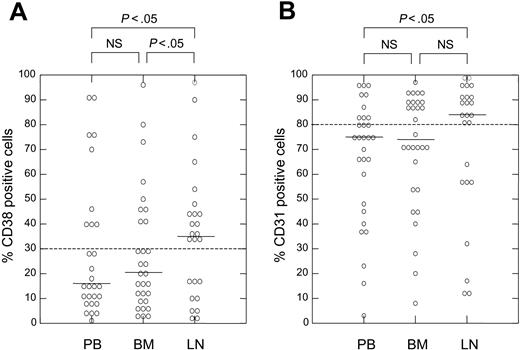We read with great interest the paper by Deaglio et al1 analyzing signaling through the CD38 molecule on B-lymphocytes in chronic lymphocytic leukemia (B-CLL). Their results suggest that CD38 is a receptor on B-CLL cells that transduces activation/differentiation signals. In B-CLL, CD38 expression can differentiate naive from memory cells, and has prognostic impact with higher expression having inferior prognosis.2 Since CD38 can be differently expressed and can have different biologic functions during B-cell development in different lymphoid compartments, Deaglio et al1 surmise that CD38 can be up-regulated in lymph nodes and bone marrow where interactions with other cells and cytokines take place. We would like to add on this issue by our analysis of the expression of CD38 and its ligand CD31 in bone marrow (BM) and lymph nodes (LNs) in addition to peripheral blood (PB).
In 33 untreated patients with B-CLL with typical immunophenotype (CD5+CD19+CD23+sIgdim), we analyzed by flow cytometry the expression of CD38 (detected by fluorescein isothiocyanate [FITC]–labeled monoclonal antibody [mAb; DAKO, Glostrup, Denmark]) and CD31 (detected by FITC-labeled mAb [Serotec, Oxford, United Kingdom]) on CD19+ cells (detected by phycoerythrin-labeled mAb [DAKO]). Results were analyzed as mean fluorescence intensity (MFI) and standardized/quantified by determining molecules of equivalent fluorochrome (MEFs; Fluorospheres, DAKO) and expressed as percentage of positive cells. Fresh samples were taken on the same day from PB, BM, and LN (by fine needle aspiration biopsy in 28 patients). There were 18 men and 15 women (median age, 65 years); 11, 14, and 8 patients were in Binet stage A, B, and C, respectively.
We found significantly higher CD38 expression in LN compared with BM or PB (median percentage 35%, vs 20% or 16%, respectively; P < .05; Wilcoxon matched pair test; for percentage, MFI, and MEFs, see Figure 1A). No significant difference was found between PB and BM, similarly to Hamblin et al3 and Arena et al,4 whereas Ghia et al5 found higher CD38 expression in BM in a subset of analyzed patients. We found expression of CD31 to be higher than expression of CD38 in all compartments. There was a higher percentage of CD31+ cells in LN than in PB (P < .05; Fisher test; > 80% vs ≤ 80% positivity, but not in other tests; Figure 1B). CD38 MEFs correlate with CD31 MEFs in each lymphoid compartment (r = 0.55; P < .05).
CD38 and CD31 expression by lymphoid compartments in patients with B-CLL. Results are presented as the percentage of (A) CD38+ and (B) CD31+ cells, and the medians are marked by solid lines. Dotted lines indicate arbitrary cutoffs. NS indicates not significant.
CD38 and CD31 expression by lymphoid compartments in patients with B-CLL. Results are presented as the percentage of (A) CD38+ and (B) CD31+ cells, and the medians are marked by solid lines. Dotted lines indicate arbitrary cutoffs. NS indicates not significant.
Higher CD38 expression in all compartments was associated with more advanced clinical stage (P < .05). The ratio of CD38/CD31 expression, especially in LN, has a more pronounced association with clinical parameters including BM insufficiency (P < .05), lymphoma-like tumor distribution6,7 (P < .05), and clinical stages (P < .05), suggesting possible interactions with coexpressed CD31.1,8 Patients with a higher CD38 expression ratio in LN relative to PB or BM have lymphoma-like tumor distribution (P < .05) and a diffuse BM infiltration pattern (P < .05), suggesting more aggressive disease irrespective of CD38 level.
Our results show that the levels of CD38 expression and to a lesser extent CD31 are significantly associated with lymphoid compartments. The higher expression in LN is probably related to different proliferation/activation status and up-regulation of CD38. It is of interest to stress that CD38 expression in LN as compared with PB or BM has a stronger relationship with clinical disease parameters.


This feature is available to Subscribers Only
Sign In or Create an Account Close Modal